Abstract
The urban drainage system plays an important role in the urban infrastructure resilience discussion. Its functional failures can trigger cascading effects on other urban systems and critical infrastructures. The main aim of this work is to investigate and quantify urban flood resilience, offering an integrated methodological approach. In this process, the flooding consequences were quantified by hydrodynamic simulations, using a case study in an exploratory research method. A set of indicators was proposed to map the cascading effects generated by floods and the consequent quantification of urban flooding resilience. Two simulation scenarios were proposed to validate the methodological assessment framework proposed in this work. The first scenario represented the current flooding situation and showed the negative effects on the city systems resulting from disordered urban growth. The second scenario considered the improvement of the drainage behavior, considering a sustainable urban drainage approach supported by the concept of blue-green infrastructure integrated with the urban open spaces system. A comprehensive flood resilience assessment over time was conducted by analyzing the evolution of the System Integrity Index on both scenarios. The results showed that water dynamics play an important role in ordering land use and that preserving water spaces can efficiently respond to urban developing threats, dealing with floods in an earlier development moment, proving the importance of the drainage system as a preliminary structuring driver for supporting a sustainable urban planning, ordered according to environmental constraints defined by water dynamics.
1. Introduction
It is not unusual to find cities where land use planning is conducted without properly considering the natural dynamics, imposing a rigid grid-like outline, disregarding the specific environment conditioning features [1,2]. The carrying capacity of natural systems cannot be neglected without negative consequences. However, this seems to be especially frequent in what regards water dynamics: urban flooding appears as one of the most significant natural disasters in global statistics [3].
Conceptually, the drainage system occupies a key position in the urban spatial analysis, acting in the interface between natural demands and the built environment needs. While the natural water cycle demands a floodway to rainwaters that are gathered in the watershed, the urban environment demands safe and healthy places for urban activities and services [4]. More sensitive ecological approaches have appeared in recent years, encouraging engineers and urban designers to work with nature [5,6,7], reorganizing spaces and flood flow patterns. However, many cities still work to “defend” themselves from floods [8] and are still seeking disaster recovery strategies [9], and are therefore focusing on the consequences. In this context, there is a gap between flood risk management and land use planning processes, which makes it difficult to increase the resilience of cities. Consequently, there is a need to build an integrative flood risk assessment tool for land use planning, improving stakeholder awareness and collaboration, strengthening risk communication, and improving both quality and access to data [10]. The need for a greater understanding of communities’ knowledge, experiences and needs is also highlighted, in order to integrate it with the current risk communication plans, with a clear and comprehensive flood map to inform communities at risk of flood hazard [11].
Failures in the operation of urban drainage systems generate several potential damages and losses to the daily city routine [12]. Globally, flooding is the most spatially diffused natural hazard, representing a major threat to cities [13]. Especially in countries with less economic stability, floods are capable of directly impacting the physical and mental health of the affected population, as well as forcing people to leave their residences to pursue refuge for a short or long period of time [14]. According to the Centre for Research on the Epidemiology of Disasters (CRED), reported flooding losses have amounted to USD 656 billion over the 20-year interval between 1997 and 2017 [15]. In response, the United Nations Sendai Framework for Disaster Risk Reduction (SFDRR) is one of the global initiatives developed to protect human lives, ecosystems, and infrastructures from natural and human-caused hazards until the year 2030 [16].
The urban major drainage system is usually designed to respond to a certain flood reference event, but when this event is exceeded, the capacity of the drainage structures will not be able to convey the higher discharges, failing and flooding city areas. Factors such as garbage accumulation in drainage networks [17], the uncontrolled soil paving and the consequent additional increase in runoff [18], or even the inadequate occupation of riverine areas and flood plains, may lead to changes that the drainage net has not been dimensioned to face [19], aggravating damages to the city [20].
Many times, the rivers are canalized, buried and hidden, disappearing as elements of the urban landscape [21], impoverishing urban biodiversity, aggravating public health problems, devaluating the built environment, and decreasing leisure opportunities, among other problems [22]. Moreover, disordered urban growth or unplanned urban sprawl can lead to damages to buildings and urban facilities, degrading and impoverishing areas exposed to floods, due to successive replacement costs and the interruption of services and business [19,23]. Flooding events can disrupt city mobility [24] and affect (and be affected by) the improper collection and disposal of sewage and municipal solid waste [25], becoming potential vehicles for spreading water-borne diseases [26]. This sequence of events can reach the critical infrastructure of a city and trigger a set of cause-and-effect connections, cascading negative effects to other systems [27] in a much wider range than that defined only by the directly flooded areas. Additionally, the lack of open spaces, usually observed in dense urban environments, is responsible for limiting the possibilities of reversing this situation, since available open areas could be responsible for offering temporary storage volumes to the drainage system. Figure 1 schematically shows the cycle of city degradation caused by the failures in the urban drainage system—in brief, when a city grows quickly, without proper planning and provision of the necessary infrastructure, the land use and river system change, aggravating flood events that strike back at the city itself, generating damages that demand new urban interventions to reduce flood losses. As the city grows, this vicious cycle is fed back.
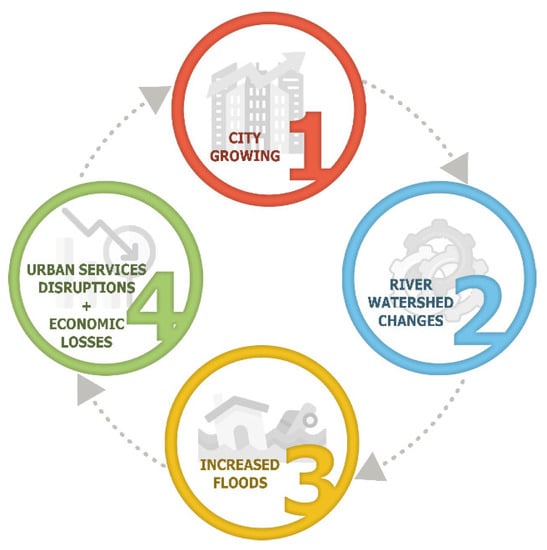
Figure 1.
City degradation cycle caused by the failures in the urban drainage system.
In this way, floods appear as a disruption driver to urban services, infrastructure networks, community facilities and housing systems. Considering that urban resilience is directly associated with the structural integrity of urban elements and the ability of urban systems to continue working under stressing conditions [28,29], the cascading effects that undermine system functions can considerably reduce city resilience [30,31].
Critical infrastructure resilience can be increased if the ability to adequately manage flood risks is properly built [32]. Flood risks can usually be reduced if floods are mitigated, if the population is no longer exposed or if the system vulnerability is reduced [33,34]. However, floods are usually difficult to mitigate, mainly due to the usual characteristics of the urban development process, since the first moments of city growing, when dense urban tissues are progressively molded without the provision of the proper open spaces needed to accommodate the natural water dynamics [35]. Removing people from floodable areas (reducing their exposure) is also difficult and provides social problems related to this relocation process (breaking affective laces and social relations, moving away from cultural heritage and working opportunities, etc.) [36]. At last, reducing vulnerability often implies adaptive strategies to live with floods, seeking to raise resilience in the context of preparing a city to be safe to fail [37]. This can also be difficult due to the costs involved and usually implies some mitigation and relocation measures. In this context, preventing risks from the beginning should be the primary aim of the urban planning process and offering ways to reach this aim is one of the main contributions of the research developed in this manuscript.
Flooding consequences are always related to space allocation in cities. That is, water needs space to develop its natural dynamics and there are frequent conflicts between urban aims and natural needs. It is more likely to find critical flooding cascading effects in cities where open spaces were not foreseen to cope with the water dynamics. This situation points to the need to deal with these conflicts, and the conception of a formal system of open spaces to provide environmental services associated with natural hydrological functions can be an alternative to ordering urban planning guidelines [38]. Considering this, our research supports the hypothesis that if this concern is considered in a timely manner, before significant urban growth, in the first stages of urban planning, it is possible to design more functional and resilient cities, avoiding future problems. Coordinating natural, technological, and socio-economic systems when designing, planning, and managing urban nature-based solutions enable optimal social-ecological outcomes [39].
Urban open spaces can provide a wide range of benefits to the citizens of a community. Parks and natural areas can be used for recreation; wetlands and forests can supply wildlife habitat; farms and forests can provide aesthetic benefits to surrounding residents; green spaces can reduce imperviousness and heat islands effects; and open spaces, in general, can provide volumes to store rainwaters [40,41,42].
As integrated systems, the concept of a blue-green infrastructure (BGI) as a functional urban system [43,44], capable of providing environmental services, appears as an alternative to reduce runoff and floods [45,46,47], increase biodiversity [48], offer cultural benefits [49], support healthier urban living style through public access to valuable natural resources [50] and make cities more resilient to climate change [51,52]. BGI can also enable the necessary connections for fragmented natural open spaces. Considering BGI concepts while designing a multifunctional opens space system can support city solutions in a sustainable way.
Given this introductory discussion, the present work proposes to investigate and quantify urban flood resilience, offering an integrated quantitative methodological approach. A case study in the city of Rio de Janeiro/Brazil, which is a dense urban and degraded area frequently affected by flooding and marked by the lack of open spaces that could mitigate floods, will be explored to test the hypothesis and validate the proposed method. In this process, a set of indicators and integrated procedures are proposed as the main contribution to the knowledge of this research area, composing an evaluation framework intended to provide a way to measure the urban flooding cascading effects and city resilience to floods as a complementary practical tool to support urban planning decisions.
Additionally, the practical assessment conducted in the exploratory case study offered here also acts as an alert for growing cities that should incorporate water dynamics issues into their urban planning process—it will be seen that an uncontrolled urban growth can produce extremely negative effects in terms of urban flood consequences spread over the watershed. As a consequence, policy implications can be possibly developed in the path of producing a more sustainable urban tissue.
The Acari River watershed, shown in Figure 2, is one of the largest and most populous in the Rio de Janeiro municipality, where there are numerous urban drainage problems, varying from gaps in the infrastructure provision to system maintenance, and consequent degradation of the natural and built environment. It is also an area recognized for its social claims. In this watershed, the urbanization did not respect the “water spaces”, occupying riparian areas and even riverbanks, in the most critical points. A previous study developed for this area [53] showed that a large portion of the population living there is not able to recover from flooding losses over time, being heavily affected even when considering flooding events of low return periods (such as 5 years, for example).
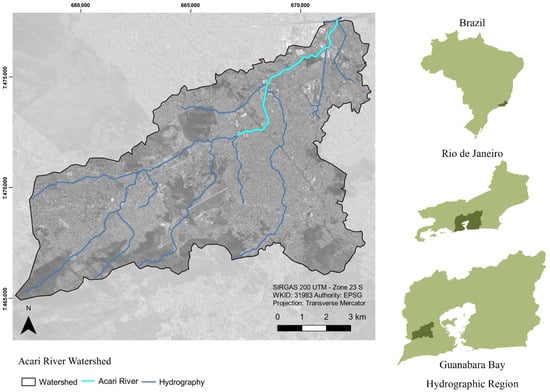
Figure 2.
Acari River watershed.
The Acari River case study works as a “laboratory”, where the hypotheses of the work are evaluated, discussed and confirmed. An urban diagnosis of the current flooding situation, the measurement of consequent cascading effects and the assessment of city resilience to floods composes the core of the proposed method offered by our approach. The final procedures can be used to manage flood risks and offer guidelines to order land use in the watershed, avoiding aggravating natural floods and providing opportunities to integrate environmental and urban needs while improving city resilience. In this way, urban open spaces will be used to provide volumes for flood control, acting as multifunctional landscapes in a blue-green infrastructure design integrated with the drainage system. Giving back spaces to the river will be a priority in the solutions presented, supporting the hypothesis that urban water dynamics should guide the initial urban land use definitions to order urban occupation in the planning process.
Therefore, this work offers as its main objective a methodological framework to evaluate the cascading effects generated by floods in the infrastructure of a city, allowing us to quantify city resilience and assess alternatives for urban planning and flood mitigation.
2. Materials and Methods
The first step in the methodological pathway refers to a diagnosis of the watershed, concerning stormwater aspects. This diagnosis is supported by hydrodynamic mathematical modeling. In this way, the current flooding situation is assessed and the impacts on flood patterns caused by the inadequate urban expansion process are mapped. The hydrodynamic simulation, in our work, was performed using the Urban Flood Cell Model—MODCEL [54].
The basic concepts of MODCEL are associated with two main aspects: the possibility of dividing the region to be modelled into flow-cells (individual compartments that characterize a homogeneous portion of the watershed) and the establishment of flow connections between every two cells using hydraulic relations capable of representing diverse types of flows and hydraulic structures. Therefore, a looped network of cells allows flows to occur in several directions of the two-dimensional plane, represented by a two-dimensional grid of irregular shaped cells. Flow-cells may be grouped to represent hydraulic structures and natural or urban landscapes. The cell arrangement and the interactions among the modelled cells aim to reproduce various possible flow patterns, inside the channel network and over the different city surfaces. This hydrodynamic model, despite working with one-dimensional hydraulic relations, can represent the flow patterns in two dimensions, which can be especially practical (and accurate) when the superficial flows are mainly conditioned by topographic barriers or urban structures. When the superficial layer is connected to the underground storm drains layer, the model creates a three-dimensional spatial network representation that jointly considers surface flows, channel flows and storm drains. Therefore, a dual drainage approach supports this model, so that flows can occur simultaneously on two superimposed layers, i.e., surface and underground [55]. This feature makes it possible to assess both river flooding and the drainage network overflows.
The model was calibrated and validated considering past precipitation events, in which the simulations showed coherent responses. The calibration and validation processes are fundamental to increase the reliability of the flood results for the different scenarios [56].
After the flood diagnosis, the impacts generated by floods on the other urban systems were quantified. Six components were considered in this analysis: Housing; Sewage System; Mobility; Community Facilities; Economy; and Cultural Heritage. Table 1 presents the indicators used for this analysis. In general, these are key factors concerning any city and they cover, which, in a broad sense, are basic needs and services related with quality of life. In particular, these components also appear in the Rio de Janeiro Metropolitan Plan [57] as the main structuring axes of urban planning for the development of the metropolis in the coming years.

Table 1.
Indicators of urban drainage impacts.
The second step intended to compute a comprehensive flood resilience evaluation. This analysis assesses the critical areas identified in the flood mapping, resulting from the mathematical modeling of the current scenario. Thereby, the System Integrity Index (Is) is proposed in this work to assess the operational behavior of a system exposed to flooding. The Is represents the mathematical computation of the urban components listed in Table 1. Firstly, according to the criteria shown in Table 1, the components of urban systems existing within the area are counted for each simulated time interval, highlighting the affected ones. Then, the Is is calculated for each system according to the formulations presented in the Table 2.

Table 2.
Formulation of the System Integrity Index for each urban system considered.
Computing the System Integrity Index for each time step allows us to draw a curve, point by point, which represents the system behavior over time. After the construction of the associated graphs, dimensionless resilience values can be obtained by the integration of the area under the graph divided by the maximum possible area of the graph, representing the regular full operational system (in which the System Integrity Index has a constant value equal to 1). The final values vary from 0 to 100%. The closer to 100%, the greater the system resilience is.
At this point, it is expected to demonstrate how drainage flaws might affect the functioning of the city, in a broad sense, reducing its resilience, while disrupting city systems, disturbing the city life and the well-being of the population. From this evidence, the drainage system is revised and modified, using sustainable urban drainage measures integrated into the open spaces system, intending to explore the possibility of recovering natural functions that should have been preserved to respect pluvial water dynamics.
Therefore, a second simulation proposes a scenario based on an ordered land use planning, driven by the drainage system adaptation needs to cope with natural demands. This scenario interacts with the open-space system through the proposal of a system of fluvial parks. Fluvial parks are parks set along riverbanks, covering the immediate riverine areas, mostly composed by green areas, and capable of providing storage volumes for floods. Mathematical modelling comparatively shows the current condition versus the proposed condition. Again, the indicators shown in Table 1 are calculated, the System Integrity Index graphs are built, and the integrated resilience values for each system are calculated (using Table 2 relations). In this way, it becomes possible to compare the proposed scenario with the current situation. The comparisons allow for showing the changes brought on by the actions on the drainage system over the other systems of the city.
3. Results and Discussion
3.1. Diagnosis
3.1.1. Urban Drainage—Diagnosis
The hydrodynamic behavior of the Acari River and its main tributaries was simulated using the computational model MODCEL, considering a design storm with a 25-years return period, as recommended by Brazilian standards. The result of the simulation allows for obtaining flood maps for the watershed. The simulation results for the current situation (Figure 3) show that the watershed presents multiple flooded areas, mainly near the main channel downstream and in the surroundings of the secondary stream courses, indicating general failures in the major drainage system.
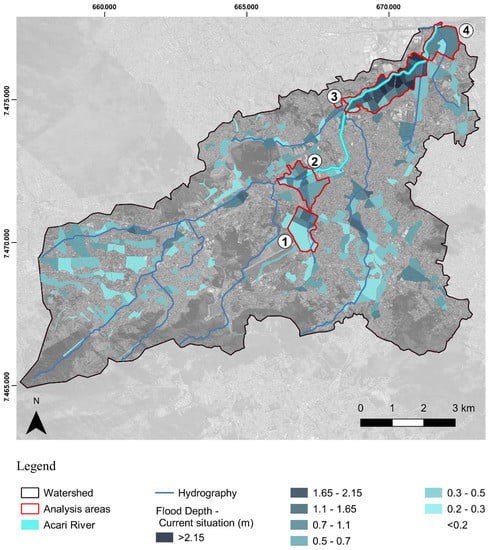
Figure 3.
Flood Map—Current situation—return period of 25 years. The figure shows the flood depths separated into 8 flooding ranges.
Specifically, four areas in the Acari River watershed can be highlighted in terms of flooding, as shown in Figure 3. Additionally, the figure shows the flood depths separated into 8 flooding ranges.
Area 1 is in the Marechal Hermes neighborhood, around Montese Square. In this area, the floods are due to difficulties in draining the Tingui River under the railroad, and the maximum water depth simulated was 1.39 m, close to the train station. This is also a traditional area, with some heritage buildings. Area 2, in turn, is the region of the confluence of Tingui River and Sapopemba River and includes part of the Deodoro, Marechal Hermes, and Guadalupe neighborhoods. In this area, floods occur due to a flow restriction caused by a low bridge, and the maximum water depths exceed 1.0 m at different points. The most critical location in this area shows a maximum water depth of 1.55 m, exactly where the confluence of both rivers occurs, consequently forming the Acari River.
The most critical of all four areas, in terms of flooding, is Area 3. This area is located upstream of Presidente Dutra Avenue and includes the Pavuna, Coelho Neto, Acari, Irajá, and Parque Colúmbia neighborhoods. The floods are caused by the lack of hydraulic capacity on the Acari River, the riverbank occupation, and the hydraulic limitations due to the pillars of bridges that partially block the floodway. In this region, the maximum water depths reach values greater than 2.0 m. It is important to note that this area is characterized by high vulnerability due to the presence of informal urban occupation on the Acari riverbanks and slums around it.
Area 4 is the region close to the mouth of the Acari River, located in the Jardim América neighborhood. The floods are due to the lack of hydraulic capacity on the Acari River and the backwater of the São João de Meriti River. The maximum water depth reaches 0.92 m.
3.1.2. Impacts Generated by Floods on Other Systems
In this section, the flooding impacts are evaluated for each considered urban system.
- Housing
The impact of flooding negatively affects housing prices [58], devaluing the built environment. Furthermore, several other aspects must be observed, such as the effects of flooding on the building structure and components, as well as on their occupants, and also on the recovery and repair activities undertaken when buildings are damaged by flooding [59]. The impact of floods on housing is a fundamental point to be observed.
The constructive standards in the Acari River watershed change spatially, depending on the type of urbanization. “Favelas” (or slums) and informal occupation show houses very close to the street level, while other regions present dwellings at higher levels, more protected from possible floods, as shown in Figure 4.
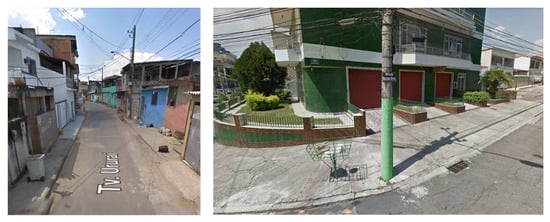
Figure 4.
Difference between the constructive standards of a “favela” (left image—located in Area 3) and regular occupations (right image—located in Area 1). Source: Street View (Google).
Observing the patterns of informal areas, we considered that flooding in the streets that exceeds 20 cm will enter the houses. In the regular areas of the watershed, the dwellings were 50 cm above the street level. From these premises, there are 46,398 dwellings flooded in the current situation. To have an idea of the amount of water entering the homes, the average flood depth was calculated for all flooded dwellings. Thus, an average flood depth of 37 cm was found to occur inside the houses.
- Sewage System
When the floodwaters invade the inside of the dwellings, they also start to enter the sewage network [60]. Therefore, once more we considered 20 cm for informal dwellings and 50 cm for formal dwellings as thresholds representing the point that generates sewage overflows and consequent contamination that affects the area where these houses are located. Thus, 46,398 dwellings contribute to the contamination of the drainage system through communication with the sewage system, affecting an area of 11,533,684 m2.
The combination of drainage and sewage networks can impact the quality of water bodies and groundwater, contaminating supply sources. The contamination of these sources of drinking water has the potential to have a more intense impact on the most vulnerable parts of the society [61].
- Mobility
Estimating flood impacts on daily activities is vital to disaster risk reduction and urban resilience. Human mobility suffers from remarkable impacts on rainy days [62]. The evaluation of flood hazard impacts on road transportation networks and consequent effects of flood-induced mobility disruptions are important aspects to be considered [63,64].
The flood depth of 50 cm would represent the blockage of mobility to the majority of the automotive vehicles (including buses). Thus, 174 km of flooded streets over 0.50 m were identified for a 25-year return period rainfall. Flooded sites represent 11% of all local roads, 14% of collectors, 13% of secondary arterials, 11% of main arterials and 9.5% of highways. Figure 5 shows the impact of floods on the watershed mobility sector. The most critical problems occur in the main roads: Presidente Dutra, linking the state of Rio de Janeiro with São Paulo (the most important economic Brazilian axis), and Brasil Avenue, the most important road of the city of Rio de Janeiro.
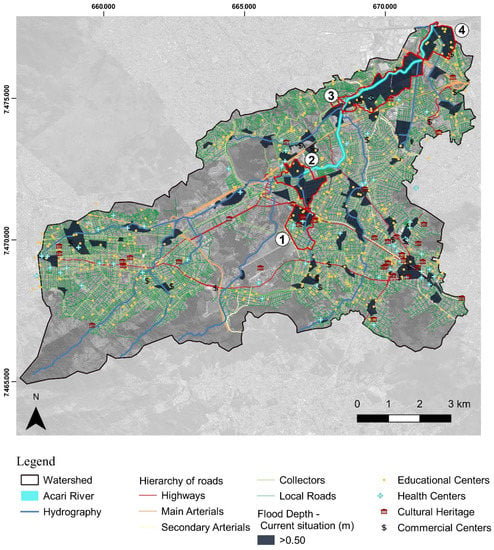
Figure 5.
Impacts generated by floods on other systems for a return period of 25 years. The figure shows areas with more than 50 centimeters of flooding that configure a critical situation for the other systems.
To obtain a single flood length number to express the relevance of flooding on mobility, an indicator was obtained by multiplying the total length of the flooded roads by a hierarchy weighting factor (local—1, collectors—2, secondary arterials—3, main arterials—4 and highways—5). Thus, we obtained the value of 270-equivalent km of weighted flooded roads.
Another crucial point in the mobility analysis refers to the identification of subway and train stations and bus stops that are affected by floods. Flood depths above 50 cm were considered to disrupt service offerings. Although metro and railway stations cannot be directly affected by floods, depths above 50 cm hinder user access to the stations. Thus, 180 points are impacted by the floods in the current situation, being 175 bus stops, 3 train stations and 2 subway stations.
- Community Facilities
Only health and educational facilities were considered in this analysis. Hospitals play a significant role in protecting the community from potentially devastating flood impacts, and it is critically important that they remain functional [65,66]. On the other hand, educational centers usually have low resilience to flood events [67] although they might play an important role as temporary shelter for those who have their houses flooded.
Similar to the previous systems, only flood depths above 50 cm were considered as critically affecting these installations. Whereas depths below this value cause annoyance, they do not completely disrupt the associated services. However, when the value of 50 cm of water is reached, health and educational facilities cannot be accessed and people inside them cannot go out. The simulated event flooded 18 health centers and 85 educational centers, corresponding to 27% and 18% of the total, respectively. The most critical region is in the vicinity of Montese Square, with 16 flooded facilities, 3 of which are health centers and 12 are educational centers. The community facilities and their interactions with floods can be seen in Figure 5.
- Economy
Quantifying the economic impacts of a flood is complex and delicate [68,69]. Many of the losses and damages occur by indirect means and cannot be easily converted into economic damages and their total precise quantification is impossible. This work focuses on the quantification of the commercial centers that are flooded (in streets with floodwater depths of 0.50 m). This assumption considers that flooded commercial centers may lose stocked goods, materials and equipment that may lead them to cease economic activities. This is a partial assessment, but it can work as a practical indicator of the severity of this effect. The simulated event reached 11 of the 21 centers of economic importance surveyed, which represents more than 50% of the total. Figure 5 pictures this situation.
- Cultural Heritage
The analyses of the cultural heritage will allow stakeholders and decision-makers to determine the potential impacts of flooding to these assets, for example, helping to prevent impacts on monuments, archeological sites, historical buildings, as well as their interiors and the collections they hold [70], which allows us to prevent high risks to the cultural heritage on a sustainable basis [71].
The work superimposed the 36 points of Cultural Heritage of the watershed with the areas of flood depth greater than 50 cm. As a result, there are five points with probable flooding for a 25-year time-critical recurrence event. Three of these five points are in the vicinity of Marechal Hermes Train Station.
3.1.3. Comprehensive Flood Resilience Assessment
A comprehensive flood resilience assessment was conducted for each of the four selected areas highlighted in the Section 3.1.1. Figure 6 presents these areas in detail, with the location of buildings (in general), transportation infrastructure, cultural heritage, commercial centers, and community facilities (health and educational centers) surveyed. In the background, the flood depths simulated for the current situation are presented.
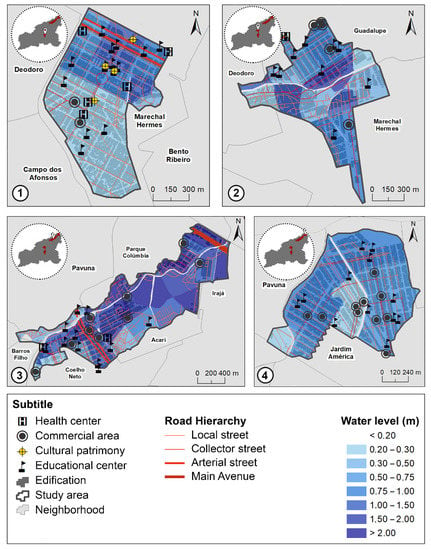
Figure 6.
Summary maps of the analysis areas—Current Situation.
In the Figure 7, the System Integrity Index is plotted in graphs presented for each of the systems considered for the resilience assessment of the current situation.
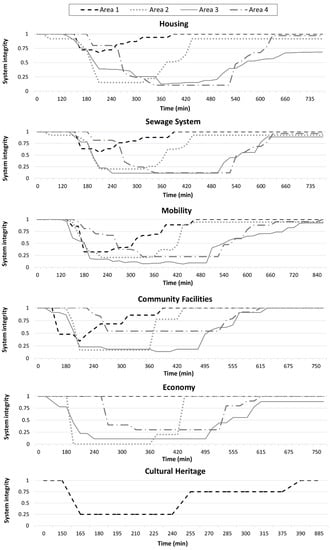
Figure 7.
System Integrity Index graphs—Current Situation.
Table 3 shows the resilience values obtained for each area and each urban system considered, based on the graphs of Figure 7. It is possible to observe that, in Area 1, the lowest resilience values refer to the Mobility (85%) and Cultural Heritage (88.6%) systems. It should be noted that these values are calculated using the whole event, integrating the calculation of the areas under the curve from time step 0 until the last simulated time step. This choice produces higher values because there are moments in which the system is not affected. However, when doing this, we can maintain the same basis of calculation, for comparison purposes. In this area, there are important roads and the main railway line of the metropolitan area of the city, besides historical buildings. With considerable flooding depths, which exceed 1.0 m in some places, these roads and cultural heritages are harmed, explaining the lower resilience for these two systems. It is noteworthy that, in this area, there are no slums or informal dwellings.

Table 3.
This is a table. Tables should be placed in the main text near to the first time they are cited.
In Area 2, the lowest resilience values are for the Economy (74.2%) and Housing (74.9%) systems. Part of this area has many dwellings in places with maximum water depths above 1.0 m. Furthermore, the region has commercial centers located in areas with water depths higher than the limit considered to cause damage. Also noteworthy is the result for the Mobility system, which reaches 75.5% due to the flooding of an important road, which is between the railway and Brasil Avenue, and several bus stops are in floodable areas. It is important to note that the Housing, Sewage, and Mobility systems need a period larger than that used in the analysis for their full recovery.
In Area 3, the resilience values found are unsatisfactory for all systems in the current situation, requiring an even longer period than that used in the analysis for recovery, except for the Community Facilities system. The worst values are for the Sewage (54.0%) and Housing (55.4%) systems, and the highest value obtained was 68.3% for the Community Facilities system. It is noteworthy that this is a very critical area of the watershed. There are many informal dwellings and slums on the riverbanks, and health, educational and commercial centers are subjected to high flooding depths, which reach 2.0 m or even more in some places. The flooding of important roads is also verified.
In Area 4, the worst resilience values obtained refer to the Housing (67.4%) and Sewage (68.0%) systems. This region has many dwellings subjected to a water depth greater than 0.50 m. This fact contributes to the low values found for these systems. On the other hand, the highest resilience value obtained is related to the Community Facilities system (84.3%).
Table 3 shows a summary of these results.
3.1.4. Diagnosis Discussion
The urban drainage diagnosis presented in Section 3.1.1 allowed us to identify the criticality of the floods in the watershed due to different causes, such as the lack of hydraulic capacity of the rivers, the flow restrictions due to existing crossings and bridges, the informal riverbank occupation, and the São João de Meriti River backwater. Thus, four areas were highlighted as critical from the analysis of the flood map obtained in the simulation of the current situation.
After that, different urban systems in the watershed were quantitatively evaluated to identify the cascading effects propagated to other urban systems. The analyses conducted, presented in Section 3.1.2, showed the vulnerability of the study watershed to floods. In addition, there is a spatial heterogeneity in the watershed regarding this vulnerability. The four critical areas highlighted concentrate most of the impact generated by floods and are representative of the flooding problem in the watershed. For example, considering Area 3 alone, it concentrates 25% of all flooded dwellings in the basin. It occurs because these regions occupy the natural riverine areas and suffer the functional deficit of the existing drainage system, which cannot cope with the excess of surface water and lacks open spaces for allocating rainwater volumes.
Finally, a comprehensive flood resilience assessment was carried out for the areas identified as critical in the watershed (Section 3.1.3). This assessment demonstrated that drainage failures directly and greatly affect urban systems, causing resilience to drop considerably, especially in Area 3, which is the most critical area in the watershed. Recovery times are also a critical factor, and, in some areas, it is not possible to observe the recovery of their infrastructure during the simulation period in the mathematical model.
Considering all these results, it is possible to raise the hypothesis that, if the water dynamics had been thought out in advance, with urban drainage acting as a structuring driver for the space planning and occupation, the watershed could experience fewer failures and greater resilience to flooding. The flood control design (shown in the next section) aims to recover storage volumes of water and protect critical infrastructure from flooding. The result to be achieved must be a watershed with greater resilience to facing flood disasters, helping to verify the proposed hypothesis.
3.2. Urban Drainage Design Supported by the Open Spaces System
Considering the impacts caused by flood occurrences, recognizing the potentialities of the open spaces system as a multifunctional element becomes a key factor in enhancing integrated urban planning in a compatible way with natural dynamics. In this work, a Design Scenario was proposed, in an exploratory procedure, with the introduction of mitigation measures supported by the open spaces system integrated with blue-green infrastructure. Blue-green infrastructure was used in the proposal of a continuous fluvial park, increasing the infiltration opportunities, and recovering natural spaces to the fluvial system.
In this context, the riverine areas with potential to be incorporated into the drainage system infrastructure were identified to compose the imagined fluvial park and receive part of the flood volumes. The mapping of the open spaces to compose the macro and micro drainage system was carried out, selecting parks and squares, mainly the ones that are already floodable (but without any control). It was also suggested to preserve the existing green and permeable areas, incorporating them into the proposed open spaces system. In the absence of potential open spaces for flood mitigation, marginal areas of the watercourse should be expropriated, relocating the population settled in irregular urban occupations, mainly if these areas are floodable and represent risk to this population. Additionally, the proposition of blue-green infrastructure considers an environmental improvement along the Acari river, including the possibility to increase the quality of life and add recreational spaces for the population.
The fluvial parks proposal considers that the riverbanks in these new areas should be lowered to work as a secondary channel of the river, acting as a multifunctional project. In periods of low waters, they will function as linear parks; in periods of floods, they will be occupied by the river waters, avoiding flooding in urbanized areas of the river vicinity. In addition to having an important function for the proper functioning of the drainage system, these parks serve as an environment connection between the segregated open spaces of the watershed. This scenario proposal also considers the incorporation of a landscape project for the fluvial park, emphasizing the importance of interdisciplinary work in the conception design.
Besides the incorporation of many existing open spaces in the flood control design, some corrections of the actual urban drainage system were also proposed. The dredging of the bottom of the Acari River was proposed in the downstream reaches to improve hydraulic capacity. It is important to note that the lack of vegetation on the riverbanks does not protect the river system in the current situation and siltation is high in the lower reaches of the watershed. Furthermore, some bridges were also modified to reduce their impacts on the flow—these structural problems must be corrected to allow a proper solution. The modification in these structures considered the elevation of the Dutra Road, responsible for a considerable bottleneck in the Acari River. We also resized the outlets of two drainage pipes, one in the vicinity of Montese Square, in the Marechal Hermes neighborhood, and another in an upstream point of the watershed, to allow a greater discharge capacity crossing the railway line. Figure 8 shows the main interventions proposed in the flood control design for the Acari River basin.
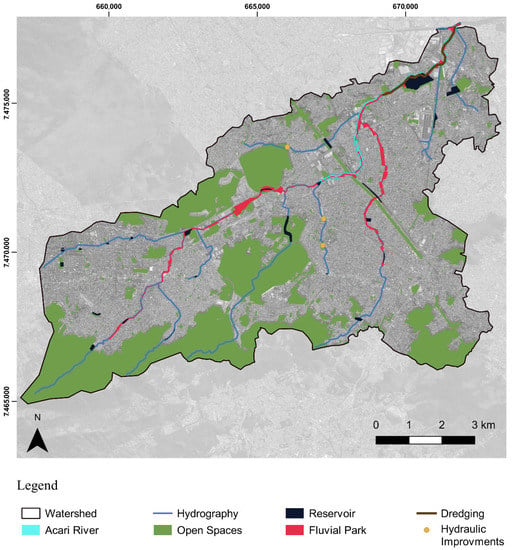
Figure 8.
Flood control design in the watershed supported using open spaces.
3.2.1. Urban Drainage—Design
Modifications were performed in the mathematical model—MODCEL—to reflect the proposed Design Scenario, and the obtained results can be observed in Figure 9 and Figure 10. The water profile along the main course of the Acari River (Figure 9) shows that overflows no longer occur in the main river for the design storm with a 25-year return period. Additionally, the flood map obtained for the Design Scenario (Figure 10) shows a significant reduction in floods when compared with the current situation. The remaining flood depths on the map are related to the non-simulation of the smaller pipes in the minor drainage system (and to real problems related to the minor drainage system performance). This consideration is consistent with the local reality since, for the return period of 25 years, it is expected that these pipes will fail (it is worth noting that this system is dimensioned for a return period of 10 years in Brazil).
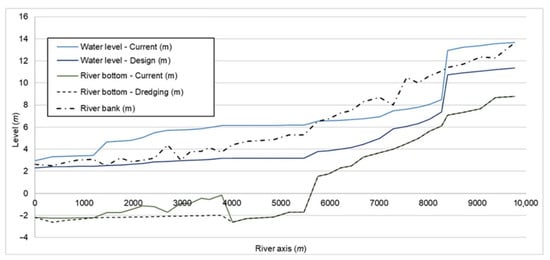
Figure 9.
Profile of the main course of the Acari River—Current situation x Design Scenario.
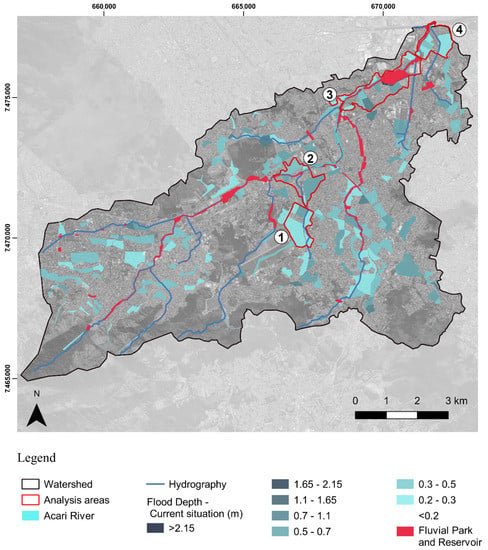
Figure 10.
Flood Map—Design scenario—return period of 25 years. The figure shows the flood depths separated into 8 flooding ranges.
3.2.2. Design Impact on Other City Systems
Taking into consideration the proposed drainage design and the current situation, the indicators regarding housing, sewage, mobility, community facilities, economy and cultural heritage were computed to identify the obtained gains to the city, as shown in Table 4. There are gains in all urban systems, but the decrease in the housing sector needs to be highlighted.

Table 4.
Comparison between Current Situation and Design Scenario.
The housing system has the second-biggest gain concerning the other indicators, with a reduction of 73.5% of flooded dwellings. Although there are still 12,291 dwellings in a situation of flooding, the state of calamity to which the most critical area of the basin was subjected has been overcome. Flooded dwellings that had an average flooding depth of 37 cm inside the house had a gain of 48.6% and improved, on average, to less than 20 cm of flooding. The composition of these two indicators indicates huge significant gains and decreases the number of dwellings affected and the flooding intensity of those that remain flooded. It is also important to note that there are no more river overflows, implying that the major drainage is equated. Minor drainage still needs to be revised. At the same time, with the improvement of the housing system, the sewage system also makes progress by reducing areas contaminated by the failure of the drainage network and its contribution to sewage networks.
3.2.3. Comprehensive Flood Resilience Assessment
Figure 11 presents the four selected areas in detail. Similar to what was conducted before, for the current situation, the location of buildings (in general), transportation infrastructure, cultural heritage, commercial centers, and community facilities (health and educational centers) are shown over a background where the flood depths obtained for the Design Scenario are presented.
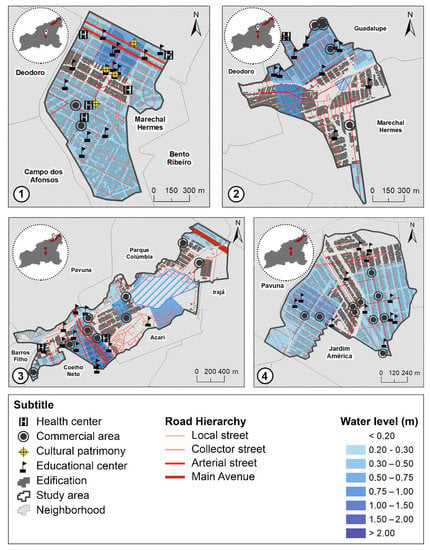
Figure 11.
Summary maps of the analysis areas—Design Scenario.
Figure 12 shows the System Integrity Index behavior for each of the systems considered in the resilience assessment for the Design Scenario.
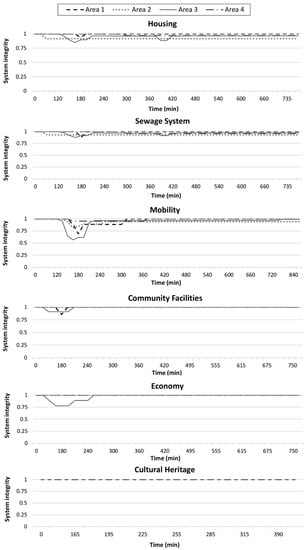
Figure 12.
System Integrity Index graphs—Design Scenario.
Table 5 shows the resilience values obtained for each area and each urban system considered, based on the computed areas of graphs shown in Figure 12. With the proposed design measures, it is possible to observe a clear flood control improvement in general in Area 1, although in the surroundings of the train station there is still a maximum water depth above 0.50 m. As a result, the resilience values increase in this scenario, reaching values close to 100.0% in all systems, except the Mobility system (97.7%).

Table 5.
Comparison between Current Situation (CS) and Design Scenario (DS)—Results of comprehensive flood resilience assessment.
In Area 2, there is a decrease in the flooding depths to a considerable extent, to levels below 0.20 m, consequently improving the resilience values of all systems. The Community Facilities and Economy systems stand out because they are not affected anymore and maintain the system integrity at 100% over the whole period considered.
There is a considerable improvement in the reduction of maximum flooding depths in Area 3 after introducing the design measures and, consequently, the system resilience also improves, reaching results that range from 95.0% (Mobility) to 99.4% (Community Facilities). The systems are still affected because, despite the significant reduction in water depths, remaining ponds are still found in the region (above 0.50 m) (Figure 11).
There is also a decrease in the maximum flooding depth to levels below 0.50 m in the whole of Area 4, being in large part less than 0.20 m. This fact contributes to the improvement of resilience values not only in the two most critical systems, which increase from 67.4% to 98.1% (Housing) and from 68.0% to 97.0% (Sewage System), but in all others, which are not affected, except the Mobility system, which increases from 69.1% to 98.9%.
3.2.4. Design Discussion
The analysis of the hydraulic behavior of the watershed after the implementation of the measures proposed in the Design Scenario, as presented in Section 3.2.1, indicates that they can solve the overflow problems of the main course of the Acari River, considering the 25-year return period reference event. In addition, the measures reduce widespread flooding in the watershed. There is a 50% reduction in the total flooded area in the watershed, with an average water depth 18 cm smaller than that found in the current situation.
As noted in Section 3.2.2, controlling overflows of the Acari River has significant impacts on urban systems and it is the first step for controlling the tributaries’ responses in the following. All systems analyzed show a reduction in flood impacts by more than half of the original effects. The proposal can improve people’s quality of life, since 34,107 houses do not flood anymore (a reduction of 73.5%), and the 12,291 houses still exposed to flooding present an average reduction of 19 cm inside them (a gain of 48.6%). There is also a reduction of more than 7000 m2 of urban areas contaminated by the interaction of drainage waters with the sewage network (a reduction of 63.54%). Regarding the urban Mobility system, 153.8 km of roads and 86 stations do not flood anymore in the proposed design situation (gains of 56.8% and 47.8%, respectively), enabling the continuity of the mobility system even in the face of extreme events. Another considerable gain is related to Community Facilities aspects. Health centers and educational centers, essential for receiving wounded people and families displaced by floods, show significant gains (greater than 60%).
There are also positive consequences to the Economic sector: 44 commercial centers are put in safe conditions (gains of 62.9%), reducing the impact of flooding on the city’s businesses. The impacts on the economic sector obviously go beyond those presented in this analysis and are associated with the quantification of direct and indirect losses caused by the cascading effects, including a long-term analysis. The quantification of these impacts are expected to be developed in more detail in future works.
The Cultural Heritage system presents the highest proportional gains. Museums, sculptures, and historic buildings of the city that were subject to flooding in the current situation are now safe in the Design Scenario. All these results corroborate the perception that urban drainage can cascade a series of negative effects.
Section 3.2.3 shows that the gains for the four most critical areas are as significant as those previously presented for the entire watershed. The design alternative proposed can reduce flooding and, additionally, the remaining ponding areas will have relatively minor impacts on the urban areas and the city can quickly recover its state of previous normality, featuring a significant increase in urban resilience, which is confirmed by the comprehensive flood resilience assessment (values above 90% for the design situation).
Thus, a comparative analysis between the results obtained in the Design Scenario with the current situation makes it possible to identify the structuring role that the urban drainage system wields in the planning and development of the city, confirming the hypothesis raised in Section 3.1.4, supporting that urban water dynamics should guide urban land use planning in a preliminary way. Once the failures of the drainage system are reduced, resulting in smaller water depths, other urban systems are less affected and can manage to recover more quickly. Therefore, the introduction of measures that favor the infiltration and storage of flood volumes and the improvement of the hydraulic capacity of existing rivers and channels can reduce the cascading effects generated by floods, thus increasing the resilience of the basin.
4. Conclusions
The main conclusion of this work is related to the finding that designing a proper drainage system and recognizing natural water dynamics needs and the watershed carrying capacity must precede and feed the urban planning process, to avoid exposing the population to risks and consequently avoid the need for future mitigation actions. The drainage system should be seen as a preliminary driver for ordering urban spaces, especially when it is possible to work preventively in growing cities, or, on the other hand, it can be a catalyst for changes, when flood mitigation is already requested in an established city. This consideration greatly reduces the possibility of cascading negative effects through city systems and consequently raises city resilience to floods.
In this work, the Acari River watershed was taken as a living laboratory to apply the proposed method, in an exploratory procedure. The research was supported by hydrodynamic mathematical modeling, complemented by the evaluation of flooding cascading effects through different urban systems, using a set of proposed indicators, and followed by a comprehensive resilience quantification for urban systems, comprising Housing, Sewage, Mobility, Community Facilities, Economy, and Cultural Heritage.
The diagnosis of the current case study situation shows how critical flooding can be in a watershed and to what extent the city services can be disrupted by these floods. A significant part of the severity of the flood problem mapped in the Acari River basin was generated by disordered urban growth, including flood plains’ irregular occupation, excess of imperviousness, and inadequate design of urban structures (low bridges, narrow channels, small pipes), among other things. This work also found that the basin poorly responds to flooding events, presenting low levels of resilience.
This diagnosis showed that urban growth was carried out disregarding natural drainage constraints as a preliminary driver for land use and occupation planning. To overcome this situation, a Design Scenario was proposed, in which flood flows are reorganized in the urban landscape and urban spaces in the vicinity of the rivers are used to allocate space for temporally storing overflows, to avoid (or minimize) the cascading effects identified in the current situation. In this way, the open spaces system appears as a partner of urban drainage solutions, offering storage volumes to restore natural hydrological functions that were lost in the urban water cycle. Specifying a multifunctional open-space system, controlling future land use and occupation in strategic areas, and consolidating blue-green infrastructure in the urban environment can play a significant role in the recovery of the drainage system functions, fostering city resilience.
In general, efforts to reclaim areas degraded by floods are huge, requiring the incorporation of former private areas into the open-space system; however, the gains obtained can be truly relevant. It is interesting to note that, in the Acari River watershed, for each house relocated from a risky area, to conform to the proposal of a longitudinal fluvial park running along the riverbanks, 15 other houses were no longer flooded in the watershed area.
The results obtained in the case study corroborate the hypothesis proposed, showing that cities with an orderly and sustainable land use process, respecting water dynamics and preserving water spaces, can respond in a more efficient way to floods. This is essential information for growing cities. The proposed multifunctional open-space system was able to significantly reduce the water levels in the main river and its tributaries, diminishing flooded areas and increasing the safety of the hydraulic structures in the floodway, significantly increasing city systems resilience.
The proposed framework of this research is replicable to other cases, allowing for a broad diagnosis of flooding behavior. It can be used as a qualifying tool for evaluating flood-managing alternatives, in the face of the potential city resilience responses. The work provides a structured method that can be used by decision-makers, such as municipal managers, in the urban planning process for flood risk mitigation and stormwater management since it allows the verification of the different flood impacts in the other systems of the city, evaluating the resilience of the urban infrastructure. In addition, this method can help to justify investments to improve the urban drainage system, since a broader view of the negative consequences that their failures can trigger all over the city can help in cost–benefit analysis, offering wider benefits when avoiding general losses of cascading effects.
Author Contributions
Conceptualization, A.K.B.d.O., B.P.B. and R.K.M.; Formal analysis, B.P.B. and M.G.M.; Investigation, A.K.B.d.O., B.P.B., M.V.R.G., F.M.C., R.d.O.P.B., V.d.A.R., I.B.L. and A.P.V.; Methodology, A.K.B.d.O., B.P.B., G.B., M.V.R.G., V.d.A.R., I.B.L., O.M.R., P.C.d.M. and M.G.M.; Software, A.K.B.d.O., R.d.O.P.B., R.K.M., O.M.R. and M.G.M.; Supervision, A.K.B.d.O., G.B., P.C.d.M., A.P.V. and M.G.M.; Writing—original draft, A.K.B.d.O., I.B.L. and M.G.M.; Writing—review & editing, B.P.B., G.B., F.M.C., O.M.R., A.P.V. and M.G.M. All authors have read and agreed to the published version of the manuscript.
Funding
This research was funded by the Fundação Carlos Chagas Filho de Amparo à Pesquisa do Estado do Rio de Janeiro (FAPERJ) grant number [E-26/200.417/2021; E-26/201.404/2021; E-26/200.270/2017]; by the Conselho Nacional de Desenvolvimento Científico e Tecnológico—Brasil (CNPq) grant number [303862/2020-3; 142284/2018-1]; by the Coordenação de Aperfeiçoamento de Pessoal de Nível Superior- Brasil (CAPES) grant number [Finance Code 001; 1526717; 88887.485239/2020-00; 88887.495814/2020-00]; and by the Programa Institucional de Bolsa de Iniciação Científica from the Federal University of Rio de Janeiro (PIBIC-UFRJ) grant number [Edital nº 169 CEG/CEPG 2020]. We also acknowledge the UNESCO Chair for Urban Drainage in Regions of Coastal Lowlands from the Federal University of Rio de Janeiro, to which this research is linked.
Data Availability Statement
The data used in the paper can be obtained by consulting the authors.
Conflicts of Interest
The authors declare no conflict of interest.
References
- Hoyle, H.; Hitchmough, J.; Jorgensen, A. All about the ‘wow factor’? The relationships between aesthetics, restorative effect and perceived biodiversity in designed urban planting. Landsc. Urban Plan. 2017, 164, 109–123. [Google Scholar] [CrossRef]
- Southon, G.E.; Jorgensen, A.; Dunnett, N.; Hoyle, H.; Evans, K.L. Perceived species-richness in urban green spaces: Cues, accuracy and well-being impacts. Landsc. Urban Plan. 2018, 172, 1–10. [Google Scholar] [CrossRef]
- Ritchie, H.; Roser, M. Natural Disasters. Available online: https://ourworldindata.org/natural-disasters (accessed on 14 April 2021).
- Miguez, M.G.; Veról, A.P.; da Rêgo, A.Q.S.F.; Lourenço, I.B. Urban Agglomeration and Supporting Capacity: The Role of Open Spaces within Urban Drainage Systems as a Structuring Condition for Urban Growth. In Urban Agglomeration; InTech: London, UK, 2018. [Google Scholar]
- Barbedo, J.; Miguez, M.; van der Horst, D.; Marins, M. Enhancing ecosystem services for flood mitigation: A conservation strategy for peri-urban landscapes? Ecol. Soc. 2014, 19, 11. [Google Scholar] [CrossRef]
- Toledo-Gallegos, V.M.; My, N.H.; Tuan, T.H.; Börger, T. Valuing ecosystem services and disservices of blue/green infrastructure. Evidence from a choice experiment in Vietnam. Econ. Anal. Policy 2022, 75, 114–128. [Google Scholar] [CrossRef]
- Ghofrani, Z.; Sposito, V.; Faggian, R. A Comprehensive Review of Blue-Green Infrastructure Concepts. Int. J. Environ. Sustain. 2017, 6, 15–36. [Google Scholar] [CrossRef]
- Miguez, M.G.; Veról, A.P.; Battemarco, B.P.; Yamamoto, L.M.T.; Brito, F.A.; Fernandez, F.F.; Merlo, M.L.; Rego, A.Q. A framework to support the urbanization process on lowland coastal areas: Exploring the case of Vargem Grande—Rio de Janeiro, Brazil. J. Clean. Prod. 2019, 231, 1281–1293. [Google Scholar] [CrossRef]
- Gharib, Z.; Yazdani, M.; Bozorgi-Amiri, A.; Tavakkoli-Moghaddam, R.; Taghipourian, M.J. Developing an integrated model for planning the delivery of construction materials to post-disaster reconstruction projects. J. Comput. Des. Eng. 2022, 9, 1135–1156. [Google Scholar] [CrossRef]
- Esmaiel, A.; Abdrabo, K.I.; Saber, M.; Sliuzas, R.V.; Atun, F.; Kantoush, S.A.; Sumi, T. Integration of flood risk assessment and spatial planning for disaster management in Egypt. Prog. Disaster Sci. 2022, 15, 100245. [Google Scholar] [CrossRef]
- Auliagisni, W.; Wilkinson, S.; Elkharboutly, M. Using community-based flood maps to explain flood hazards in Northland, New Zealand. Prog. Disaster Sci. 2022, 14, 100229. [Google Scholar] [CrossRef]
- Rezende, O.M.; Ribeiro da Cruz de Franco, A.B.; Beleño de Oliveira, A.K.; Miranda, F.M.; Pitzer Jacob, A.C.; Martins de Sousa, M.; Miguez, M.G. Mapping the flood risk to Socioeconomic Recovery Capacity through a multicriteria index. J. Clean. Prod. 2020, 255, 120251. [Google Scholar] [CrossRef]
- Dewan, A. Floods in a Megacity: Geospatial Techniques in Assessing Hazards, Risk and Vulnerability, 1st ed.; Springer: Dordrecht, The Netherlands, 2013. [Google Scholar]
- Uddin, K.; Matin, M.A. Potential flood hazard zonation and flood shelter suitability mapping for disaster risk mitigation in Bangladesh using geospatial technology. Prog. Disaster Sci. 2021, 11, 100185. [Google Scholar] [CrossRef]
- CRED; UNISDR. Economic Losses, Poverty & Disasters–1998–2017; UNISDR: Geneva, Switzerland, 2017; p. 33. [Google Scholar]
- Urrutia, J.M.; Scheffczyk, K.; Riembauer, G.; Mendoza, J.; Yanez, D.; Jímenez, S.; Ramírez, A.; Acosta, M.; Argüello, J.; Huerta, B.; et al. A validated geospatial model approach for monitoring progress of the Sendai Framework: The example of people affected in agriculture due to flooding in Ecuador. Prog. Disaster Sci. 2022, 15, 100233. [Google Scholar] [CrossRef]
- Chandrasena, D.C.N.; Yusof, K.B.W.; Liyanapathirana, V.C.; Mustafa, M.R.U.; Mustaffa, Z. Blocked Drains Syndrome: Physical Degradation of the Storm Drainage System in a Compact City. Adv. Sci. Lett. 2017, 23, 1407–1411. [Google Scholar] [CrossRef]
- Silveira, A.L.L. Problems of modern urban drainage in developing countries. Water Sci. Technol. 2002, 45, 31–40. [Google Scholar] [CrossRef] [PubMed]
- Veról, A.P.; Battemarco, B.P.; Merlo, M.L.; Machado, A.C.M.; Haddad, A.N.; Miguez, M.G. The urban river restoration index (URRIX)-A supportive tool to assess fluvial environment improvement in urban flood control projects. J. Clean. Prod. 2019, 239, 118058. [Google Scholar] [CrossRef]
- Haddad, E.A.; Teixeira, E. Economic impacts of natural disasters in megacities: The case of floods in São Paulo, Brazil. Habitat Int. 2015, 45, 106–113. [Google Scholar] [CrossRef]
- Machado, A.C.M.; Veról, A.P.; Battemarco, B.P.; Miguez, M.G. Proposal of a complementary tool to assess environmental river quality: The River Classification Index (RCI). J. Clean. Prod. 2020, 254, 120000. [Google Scholar] [CrossRef]
- Capps, K.A.; Bentsen, C.N.; Ramírez, A. Poverty, urbanization, and environmental degradation: Urban streams in the developing world. Freshw. Sci. 2016, 35, 429–435. [Google Scholar] [CrossRef]
- Secron, M.B.; Montaño, M.; Miguez, M.G.; Jonoski, A.; de Azevedo, J.P.S.; Popescu, I.; Rosman, P.C.C. Proposal of a hydric index to support industrial site location decision-making applying a fuzzy multi-attribute methodology. Ecol. Indic. 2017, 83, 427–440. [Google Scholar] [CrossRef]
- Petit-Boix, A.; Sevigné-Itoiz, E.; Rojas-Gutierrez, L.A.; Barbassa, A.P.; Josa, A.; Rieradevall, J.; Gabarrell, X. Floods and consequential life cycle assessment: Integrating flood damage into the environmental assessment of stormwater Best Management Practices. J. Clean. Prod. 2017, 162, 601–608. [Google Scholar] [CrossRef]
- Low, K.S.; Balamurungan, G. Urbanization and Urban Water Problems in Southeast Asia a Case of Unsustainable Development Low Kwai Sire and G. Balamurugan Institute for Advanced Studies, University of Malaya, Kuala Lumpur, Malaysia. J. Environ. Manag. 1991, 32, 195–209. [Google Scholar]
- Alderman, K.; Turner, L.R.; Tong, S. Floods and human health: A systematic review. Environ. Int. 2012, 47, 37–47. [Google Scholar] [CrossRef] [PubMed]
- Dueñas-Osorio, L.; Vemuru, S.M. Cascading failures in complex infrastructure systems. Struct. Saf. 2009, 31, 157–167. [Google Scholar] [CrossRef]
- Gibson, M.J.; Chen, A.S.; Khoury, M.; Vamvakeridou-Lyroudia, L.S.; Stewart, D.; Wood, M.; Savić, D.A.; Djordjević, S. Case study of the cascading effects on critical infrastructure in Torbay coastal/pluvial flooding with climate change and 3D visualisation. J. Hydroinformatics 2020, 22, 77–92. [Google Scholar] [CrossRef]
- Chen, K.F.; Leandro, J. A Conceptual time-varying flood resilience index for urban areas: Munich city. Water 2019, 11, 830. [Google Scholar] [CrossRef]
- Sathurshan, M.; Saja, A.; Thamboo, J.; Haraguchi, M.; Navaratnam, S. Resilience of Critical Infrastructure Systems: A Systematic Literature Review of Measurement Frameworks. Infrastructures 2022, 7, 67. [Google Scholar] [CrossRef]
- Almaleh, A.; Tipper, D. Risk-based criticality assessment for smart critical infrastructures. Infrastructures 2022, 7, 3. [Google Scholar] [CrossRef]
- De Bruijn, K.M.; Maran, C.; Zygnerski, M.; Jurado, J.; Burzel, A.; Jeuken, C.; Obeysekera, J. Flood resilience of critical infrastructure: Approach and method applied to Fort Lauderdale, Florida. Water 2019, 11, 517. [Google Scholar] [CrossRef]
- Ha, H.; Bui, Q.D.; Nguyen, H.D.; Pham, B.T.; Lai, T.D.; Luu, C. A practical approach to flood hazard, vulnerability, and risk assessing and mapping for Quang Binh province, Vietnam. Environ. Dev. Sustain. 2022, 1, 1–30. [Google Scholar] [CrossRef]
- Li, C.; Liu, M.; Hu, Y.; Wang, H.; Zhou, R.; Wu, W.; Wang, Y. Spatial distribution patterns and potential exposure risks of urban floods in Chinese megacities. J. Hydrol. 2022, 610, 127838. [Google Scholar] [CrossRef]
- Battemarco, B.P.; Tardin-Coelho, R.; Veról, A.P.; de Sousa, M.M.; da Fontoura, C.V.T.; Figueiredo-Cunha, J.; Barbedo, J.M.R.; Miguez, M.G. Water dynamics and blue-green infrastructure (BGI): Towards risk management and strategic spatial planning guidelines. J. Clean. Prod. 2022, 333, 129993. [Google Scholar] [CrossRef]
- Tubridy, F.; Lennon, M.; Scott, M. Managed retreat and coastal climate change adaptation: The environmental justice implications and value of a coproduction approach. Land Use Policy 2022, 114, 105960. [Google Scholar] [CrossRef]
- Meerow, S.; Newell, J.P.; Stults, M. Defining urban resilience: A review. Landsc. Urban Plan. 2016, 147, 38–49. [Google Scholar] [CrossRef]
- Brody, S.D.; Highfield, W.E. Open space protection and flood mitigation: A national study. Land Use Policy 2013, 32, 89–95. [Google Scholar] [CrossRef]
- McPhearson, T.; Cook, E.M.; Berbés-Blázquez, M.; Cheng, C.; Grimm, N.B.; Andersson, E.; Barbosa, O.; Chandler, D.G.; Chang, H.; Chester, M.V.; et al. A social-ecological-technological systems framework for urban ecosystem services. One Earth 2022, 5, 505–518. [Google Scholar] [CrossRef]
- Meerow, S.; Newell, J.P. Spatial planning for multifunctional green infrastructure: Growing resilience in Detroit. Landsc. Urban Plan. 2017, 159, 62–75. [Google Scholar] [CrossRef]
- Paolinelli, G.; Cei, M.; Cristiani, N.; Marinaro, L.; Veronesi, F. Don’t Split Them Up! Landscape Design of Multifunctional Open Spaces Suitable for Coping with Flash Floods and River Floods. Sustainability 2022, 14, 2316. [Google Scholar] [CrossRef]
- Lourenço, I.B.; Guimarães, L.F.; Alves, M.B.; Miguez, M.G. Land as a sustainable resource in city planning: The use of open spaces and drainage systems to structure environmental and urban needs. J. Clean. Prod. 2020, 276, 123096. [Google Scholar] [CrossRef]
- Da Silva, J.M.C.; Wheeler, E. Ecosystems as infrastructure. Perspect. Ecol. Conserv. 2017, 15, 32–35. [Google Scholar] [CrossRef]
- Ahmed, S.; Meenar, M.; Alam, A. Designing a Blue-Green Infrastructure (BGI) Network: Toward Water-Sensitive Urban Growth Planning in Dhaka, Bangladesh. Land 2019, 8, 138. [Google Scholar] [CrossRef]
- Alves, A.; Gersonius, B.; Kapelan, Z.; Vojinovic, Z.; Sanchez, A. Assessing the Co-Benefits of green-blue-grey infrastructure for sustainable urban flood risk management. J. Environ. Manag. 2019, 239, 244–254. [Google Scholar] [CrossRef] [PubMed]
- Thorne, C.R.; Lawson, E.C.; Ozawa, C.; Hamlin, S.L.; Smith, L.A. Overcoming uncertainty and barriers to adoption of Blue-Green Infrastructure for urban flood risk management. J. Flood Risk Manag. 2018, 11, S960–S972. [Google Scholar] [CrossRef]
- O’Donnell, E.; Thorne, C.; Ahilan, S.; Arthur, S.; Birkinshaw, S.; Butler, D.; Dawson, D.; Everett, G.; Fenner, R.; Glenis, V.; et al. The blue-green path to urban flood resilience. Blue Green Syst. 2020, 2, 28–45. [Google Scholar] [CrossRef]
- Filazzola, A.; Shrestha, N.; MacIvor, J.S. The contribution of constructed green infrastructure to urban biodiversity: A synthesis and meta-analysis. J. Appl. Ecol. 2019, 56, 2131–2143. [Google Scholar] [CrossRef]
- Bacchin, T.K.; Ashley, R.; Sijmons, D.; Zevenbergen, C.; van Timmeren, A. Green-blue multifunctional infrastructure: An urban landscape system design new approach. In Proceedings of the 13th International Conference on Urban Drainage, Sarawak, Malaysia, 7–12 September 2014; Volume 4, pp. 1–8. [Google Scholar]
- Gehrels, H.; van der Meulen, S.; Schasfoort, F.; Bosch, P.; Brolsma, R.; van Dinther, D.; Geerling, G.; Goossens, M.; Jacobs, C.; de Jong, M.; et al. Designing Green and Blue Infrastructure to Support Healthy Urban Living; Wageningen University & Research: Wageningen, The Netherlands, 2016; p. 111. [Google Scholar]
- Kazmierczak, A.; Carter, J. Adaptation to Climate Change Using Green and Blue Infrastructure A Database of Case Studies; Wageningen University & Research: Wageningen, The Netherlands, 2010; p. 182. [Google Scholar]
- Almaaitah, T.; Appleby, M.; Rosenblat, H.; Drake, J.; Joksimovic, D. The potential of Blue-Green infrastructure as a climate change adaptation strategy: A systematic literature review. Blue Green Syst. 2021, 3, 223–248. [Google Scholar] [CrossRef]
- Guimarães, L.F.; Miguez, M.G. A New Approach to Assess Cascading Effects of Urban Floods: The Social Impact. In Proceedings of the 2nd LA SDEWES Conference, SDEWES Centre, Buenos Aires, Argentina, 9–12 February 2020; pp. 1–11. [Google Scholar]
- Miguez, M.G.; Battemarco, B.P.; de Sousa, M.M.; Rezende, O.M.; Veról, A.P.; Gusmaroli, G. Urban flood simulation using MODCEL-an alternative quasi-2D conceptual model. Water 2017, 9, 445. [Google Scholar] [CrossRef]
- Miguez, M.G.; Radesca, F.D.; Veról, A.P.; Sousa, M.M.; Oliveira, L.F.G.S. Multilayer Modelling as a Supporting Tool for Flood Diagnosis and Drainage System Design. In New Trends in Urban Drainage Modelling. UDM 2018. Green Energy and Technology; Mannina, G., Ed.; Springer: Cham, Switzerland, 2018; pp. 490–495. [Google Scholar]
- Beleño de Oliveira, A.K.; Rezende, O.M.; Martins de Sousa, M.; Nardini, A.; Miguez, M.G. An alternative flood model calibration strategy for urban watersheds: The case study of Riohacha, Colombia. Water Sci. Technol. 2019, 79, 2095–2105. [Google Scholar] [CrossRef]
- IRM. Instituto Rio Metrópole. Strategic Plan for Integrated Urban Development for the Metropolitan Region of Rio de Janeiro. In Portuguese: Plano Estratégico de Desenvolvimento Urbano Integrado da Região Metropolitana do Rio de Janeiro (PEDUI/RMRJ) . 2017. Available online: https://www.modelarametropole.com.br/ (accessed on 6 May 2019).
- Dubé, J.; AbdelHalim, M.; Devaux, N. Evaluating the impact of floods on housing price using a spatial matching difference-in-differences (SM-DID) approach. Sustainability 2021, 13, 804. [Google Scholar] [CrossRef]
- Ahadzie, D.K.; Mensah, H.; Simpeh, E. Impact of floods, recovery, and repairs of residential structures in Ghana: Insights from homeowners. GeoJournal 2022, 87, 3133–3148. [Google Scholar] [CrossRef]
- Mohammed, M.H.; Zwain, H.M.; Hassan, W.H. Modeling the impacts of climate change and flooding on sanitary sewage system using SWMM simulation: A case study. Results Eng. 2021, 12, 100307. [Google Scholar] [CrossRef]
- Sohail, M.T.; Mahfooz, Y.; Aftab, R.; Yen, Y.; Talib, M.A.; Rasool, A. Water quality and health risk of public drinking water sources: A study of filtration plants installed in Rawalpindi and Islamabad, Pakistan. Desalin. Water Treat. 2020, 181, 239–250. [Google Scholar] [CrossRef]
- Liu, X.; Yang, S.; Ye, T.; An, R.; Chen, C. A new approach to estimating flood-affected populations by combining mobility patterns with multi-source data: A case study of Wuhan, China. Int. J. Disaster Risk Reduct. 2021, 55, 102106. [Google Scholar] [CrossRef]
- He, Y.; Rentschler, J.; Avner, P.; Gao, J.; Yue, X.; Radke, J. Mobility and Resilience a Global Assessment of Flood Impacts on Road Transportation Networks. 2022. Available online: https://openknowledge.worldbank.org/handle/10986/37452 (accessed on 26 August 2022).
- Wiśniewski, S.; Kowalski, M.; Borowska-Stefańska, M. Flooding and mobility: A polish analysis. Environ. Hazards 2021, 20, 300–322. [Google Scholar] [CrossRef]
- Yazdani, M.; Mojtahedi, M.; Loosemore, M.; Sanderson, D. A modelling framework to design an evacuation support system for healthcare infrastructures in response to major flood events. Prog. Disaster Sci. 2022, 13, 100218. [Google Scholar] [CrossRef]
- Yazdani, M.; Mojtahedi, M.; Loosemore, M.; Sanderson, D.; Dixit, V. An integrated decision model for managing hospital evacuation in response to an extreme flood event: A case study of the Hawkesbury-Nepean River, NSW, Australia. Saf. Sci. 2022, 155, 105867. [Google Scholar] [CrossRef]
- Yin, J.; Jing, Y.; Yu, D.; Ye, M.; Yang, Y.; Liao, B. A vulnerability assessment of urban emergency in schools of Shanghai. Sustainability 2019, 11, 349. [Google Scholar] [CrossRef]
- Welch, K.; Lambert, L.H.; Lambert, D.M.; Kenkel, P. Flood-Induced Disruption of an Inland Waterway Transportation System and Regional Economic Impacts. Water 2022, 14, 753. [Google Scholar] [CrossRef]
- Su, X.; Shao, W.; Liu, J.; Jiang, Y.; Wang, K. Dynamic assessment of the impact of flood disaster on economy and population under extreme rainstorm events. Remote Sens. 2021, 13, 3924. [Google Scholar] [CrossRef]
- Sesana, E.; Gagnon, A.S.; Ciantelli, C.; Cassar, J.A.; Hughes, J.J. Climate change impacts on cultural heritage: A literature review. Wiley Interdiscip. Rev. Clim. Chang. 2021, 12, e710. [Google Scholar] [CrossRef]
- Cacciotti, R.; Kaiser, A.; Sardella, A.; de Nuntiis, P.; Drdácký, M.; Hanus, C.; Bonazza, A. Climate change-induced disasters and cultural heritage: Optimizing management strategies in Central Europe. Clim. Risk Manag. 2021, 32, 100301. [Google Scholar] [CrossRef]
Publisher’s Note: MDPI stays neutral with regard to jurisdictional claims in published maps and institutional affiliations. |
© 2022 by the authors. Licensee MDPI, Basel, Switzerland. This article is an open access article distributed under the terms and conditions of the Creative Commons Attribution (CC BY) license (https://creativecommons.org/licenses/by/4.0/).